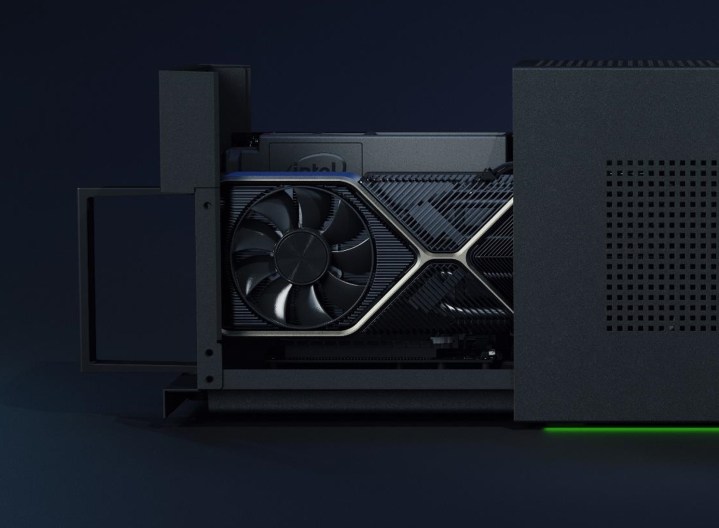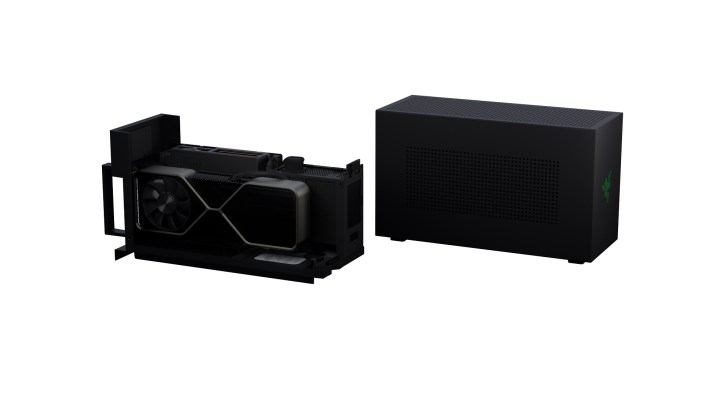After having made a name for itself among gamers with sleek laptop designs that are as powerful as they are beautiful, Razer is now entering the gaming desktop space. The company previewed its Tomahawk modular gaming desktop earlier this year at CES, and it is finally available to Razer fans who want a gaming rig that comes with Razer’s signature and minimalist aesthetics, along with a few key features that help set this PC apart from others.
At a glance, the Tomahawk bears a striking resemblance to the company’s earlier external GPU enclosures, like the Razer Core and Core X Chroma. Despite its compact size, this modular desktop is built for performance and Razer is clearly targeting PC tinkerers and builders with its toolless sled design, which provides access to the system’s internals with a clever pull-out handle.

“Its compact form boasts serious specs, yet remains modular enough to meet the ever-raising bar of high-end PC performance,” the company said during a presentation. Razer says the Tomahawk is designed around Intel’s latest Next Unit of Computing (NUC) PC design. Highlights of this design include being able to easily access the SSD to upgrade storage, a toolless design that lets you upgrade your system’s build at will, and the ability to support full-size desktop graphics — all in a diminutive 10L form factor. For comparison, Alienware’s Aurora gaming desktop comes in at a volume of 33.8L, or more than three times the size of the Tomahawk.
Razer’s attention to detail is present on the Tomahawk. The desktop supports Razer’s Chroma lighting underneath, and the company’s glowing green logo adorns the front side. LED lighting seems to be very tastefully done and not garish, like on some of the more gaming-forward rigs we’ve seen in the past.

The top and side panels feature perforated holes to aid in thermal regulation. Air is pulled in through the perforated sides, and two fans help drive hot air out the top, “away from mission-critical components,” the company said.
A handle is found on the rear, but unlike some of Lenovo’s Legion desktops, this is not a carry handle to make it easy to tote this compact rig to LAN parties. Instead, pulling on the handle allows you to access the Tomahawk’s sled, which gives you access to the GPU and other system components. All the ports are also rear-mounted — including USB-A and Thunderbolt 3 ports — which could make the ports harder to access but gives the Tomahawk a cleaner overall design.

Razer claims the Tomahawk can accommodate a card up to 320mm long and 140mm high in a full 16X PCIE Gen 3 slot. The Tomahawk ships with either an empty GPU slot, so that you can use your own graphics card, or you can configure it with Nvidia’s GeForce RTX 3080 Founders Edition card. And with a 750W SFX PSU, this system can handle the latest GPUs on the market today.
For performance, you’ll have access to two PCIE NVME slots for storage, alongside a 2TB HDD. In addition to gamers, Razer is also targeting professional creators with this system. If you buy into Razer’s design aesthetics and the company’s vision for a high-end PC, you’ll have to fork out at least $2,399 to get the Tomahawk. For that price, you’re getting a 9th-Gen Intel Core i9-9980HK CPU, 512GB SSD and 2TB hard drive, 16GB of RAM, and Wi-Fi 6 support. Unfortunately, even at this pricey configuration, you’re not getting a GPU with the unit. If you want a version that ships with a graphics card, the $3,199 configuration comes with an RTX 3080.



